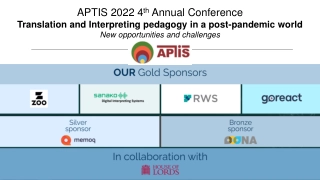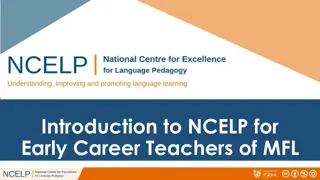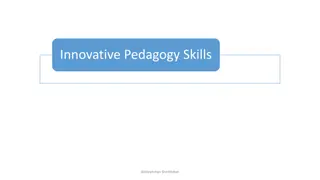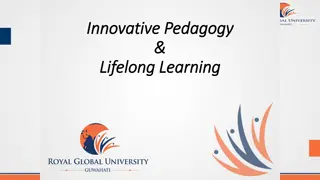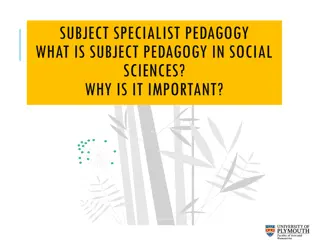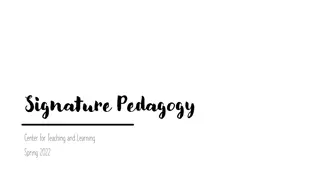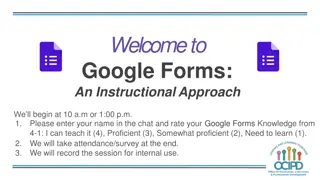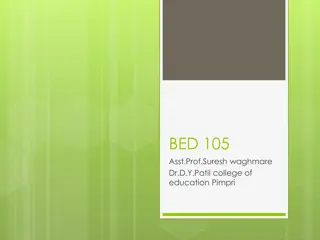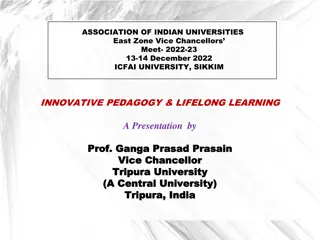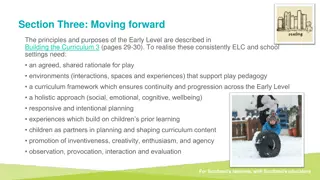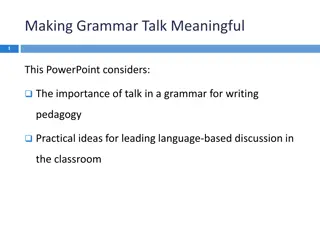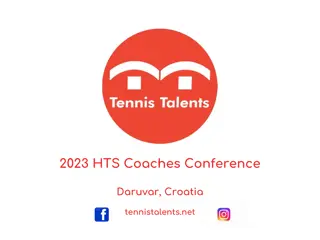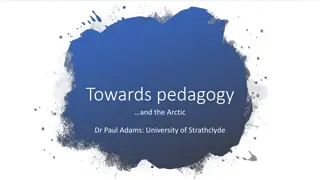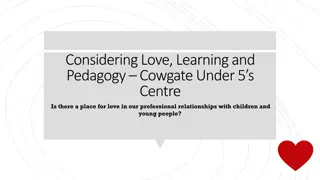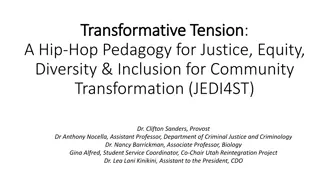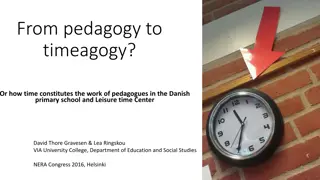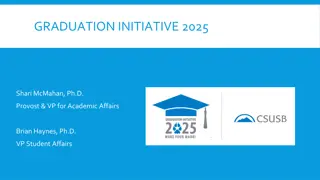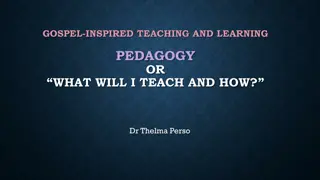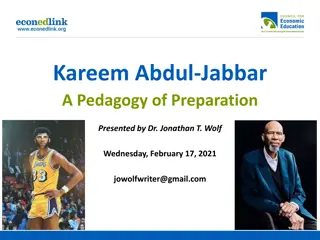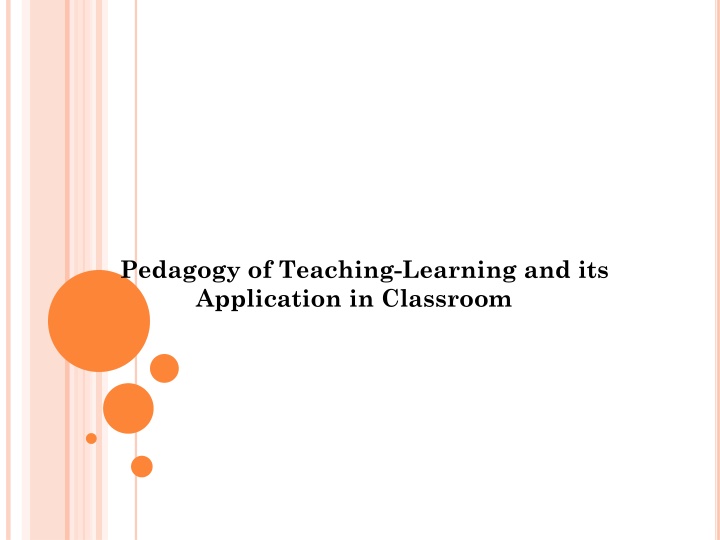
Effective Teaching-Learning Methods and Applications in Classroom
Explore the concept of pedagogy and its application in education, focusing on the exchange of knowledge and skills in different contexts. Delve into teaching-learning methods for the 3Rs, verbal conditioning, and psychomotor skills development. Understand how pedagogy shapes the growth of learners and impacts the educational process.
Download Presentation

Please find below an Image/Link to download the presentation.
The content on the website is provided AS IS for your information and personal use only. It may not be sold, licensed, or shared on other websites without obtaining consent from the author. If you encounter any issues during the download, it is possible that the publisher has removed the file from their server.
You are allowed to download the files provided on this website for personal or commercial use, subject to the condition that they are used lawfully. All files are the property of their respective owners.
The content on the website is provided AS IS for your information and personal use only. It may not be sold, licensed, or shared on other websites without obtaining consent from the author.
E N D
Presentation Transcript
Pedagogy of Teaching-Learning and its Application in Classroom
Concept of Pedagogy: Pedagogy (/ p d d i/, / p d o d i/, or / p d i/) (most commonly understood as the approach to teaching) refers more broadly to the theory and practice of education, and how this influences the growth of learners. Pedagogy, taken as an academic discipline, is the study of how knowledge and skills are exchanged in an educational context, and it considers the interactions that take place during learning. Pedagogies vary greatly, as they reflect the different social, political, cultural contexts from which they emerge.[1]Pedagogy is the act of teaching.[2]Theories of pedagogy increasingly identify the student as an agent, and the teacher as a facilitator. Conventional western pedagogies, however, view the teacher as knowledge holder and student as the recipient of knowledge (described by Paulo Freire as "banking methods"[3]). Pedagogy, literally translated, is the art or science of teaching children. The word comes from the ancient Greek paidagogos, a compound comprised of "paidos" (child) and "agogos" (leader).
Teaching Learning of 3Rs: The phrase "the Three Rs" may have originated in a speech made by Sir William Curtis in 1795. but this origination is disputed in the publication The Mirror of Literature, Amusement, 5.[4][5]An extended modern version of the three Rs consists of the "functional skills of literacy, numeracy and ICT".[6] There is an earlier reference to the skills of reading, writing, and arithmetic Augustine's Confessions (c. 397-401), though of course the words do not begin with 'R' in Latin and Instruction, Volume in St
Teaching Learning of Verbal Conditioning: The individual is constantly engaged in acquiring, assimilating, and manipulating words and symbols. An analysis of the individual's verbal behavior provides one with clues for the understanding of his thoughts, temperamental characteristics. The knowledge obtained from such analysis can be subsequently utilized in predicting his future course of action. Thus, a proper study of man should begin with man's verbal output. The symbols are verbal and are expressed through speech that allows them to be easily manipulated. However, the vocal characteristics of languages are of secondary importance. The basic element of speech is the word. Phonemes are the basic sound elements of a word, but are not the significant elements of speech. Verbal conditioned responses (CRs) are not only adaptive responses, but serve to change the conditions under which they occur. enduring attitudes, and
Teaching Learning of Psychomotor Skill: Psychomotor learning functions and physical movement. Psychomotor learning is demonstrated by physical skills such as movement, coordination, manipulation, dexterity, grace, strength, speed actions which demonstrate the fine or gross motor skills, such as use of precision instruments or tools, and walking. Behavioral examples include driving a car, throwing a ball, and playing a musical instrument. In psychomotor learning research, attention is given to the learning of coordinated activity involving the arms, hands, fingers, and feet, while verbal processes are not emphasized.[1] Stages of psychomotor development: According to Paul Fitts and Michael Posner's three-stage model, when learning psychomotor skills, the cognitive stages, the the autonomic stage.[2]The cognitive stage is marked by awkward slow and choppy movements that the learner tries to control. The learner has to think about each movement before attempting it. In the associative stage, the learner spends less time thinking about every detail, however, the movements are still not a permanent part of the brain. In the autonomic stage, the learner can refine the skill through practice, but no longer needs to think about the movement. is the relationship between cognitive individuals associative progress through stage, and Cont .
Factors affecting psychomotor skills: Psychological feedback Amount of practice Task complexity Work distribution Motive-incentive conditions Environmental factors
Teaching Learning of Principles and Concept: Educational psychologists several principles of learning, also referred to as laws of learning, which seem generally applicable to the learning process. These principles have been discovered, tested, and used in practical situations. They provide additional insight into what makes people learn most effectively. Edward Thorndike developed the first three "Laws of learning:" readiness, exercise, and effect. Concept learning, also known as category learning, concept attainment, and concept formation, is defined by Bruner, Goodnow, & Austin (1967) as "the search for and listing of attributes that can be used to distinguish exemplars from non exemplars of various categories". More simply put, concepts are the mental categories that help us classify objects, events, or ideas, building on the understanding that each object, event, or idea has a set of common relevant features. Thus, concept learning is a strategy which requires a learner to compare and contrast groups or categories that contain concept-relevant features with groups or categories that do not contain concept-relevant features. and pedagogues have identified Cont .
Concept Learning: Inferring a Boolean-valued function from training examples of its input and output. A concept is an idea of something formed by combining all its features or attributes which construct the given concept. Every concept has two components: Attributes: features that one must look for to decide whether a data instance is a positive one of the concept. A rule: denotes what conjunction of constraints on the attributes will qualify as a positive instance of the concept. Types of Concept: Concrete or Perceptual Concepts vs Abstract Concepts Defined (or Relational) and Associated Concepts Complex Concepts Methods of Learning a Concept: Discovery Examples Words Exemplars comparison and contrast
Teaching Learning of Problem Solving: Problem-based centered pedagogy in which students learn about a subject through the experience of solving an open- ended problem found in trigger material. The PBL process does not focus on problem solving with a defined solution, but it allows for the development of other desirable skills and attributes. This includes knowledge acquisition, enhanced group collaboration and communication. The PBL process was developed for medical education and has since been broadened in applications for other programs of learning. The process allows for learners to develop skills used for their future practice. It enhances critical appraisal, literature retrieval and encourages ongoing learning within a team environment. learning (PBL) is a student-
Advantages and DisAdvantages of Problem Solving: Fosters Student Centered learning Upholds lifelong learning In-depth learning Self learning Better understanding Self motivated Higher level of Learning Enhance teacher student relationship Disadvantages: Time consuming Traditional assumptions of the students Cognitive load Role of instructor Not easy to implement
Teaching Learning of Knowledge Construction: Learning is the process of creating and constructing knowledge and some individuals learning may occur in educational system. As students try to improve their learning, they take part in the learning- teaching process. Students learning in school is intentionally designed to monitor their learning and this process is called the learning-teaching process. Learning-teaching process operates by means of interaction between students, teachers and knowledge. Students and teachers don t have sufficient time to create and construct knowledge in the learning-teaching process and teachers mostly transmit and distribute ready-made knowledge in this process. Thus, students must follow their teachers plans and other education policy-makers who decide what type of knowledge and experiences are important for students learning. Creating and constructing knowledge cannot be the primary aims for them in the formal learning-teaching system. However, the creation and construction of knowledge must be the main issues in the learning-teaching process. For this reason, this paper aims at discussing the construction and reconstruction of knowledge in learning-teaching process based on phenomenological approach in education.
Principles of Knowledge Construction: Aim to make learners understand a few key ideas in- depth manner, rather than taking up so many topics superficially. Give varied examples. Provide opportunities for experimentation. Provide lots of opportunities for quality interaction. Have lots of hands-on activities. Relate your topic to real life situations.. Do not depend on the explanation method all the time.

